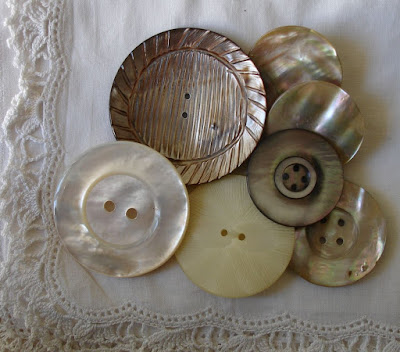Ya, it's cool and a keeper.
So talking about old things, I am in some groups here in Berlin and they have watched how I always have something in my hands that I am working on. I put out feelers to anyone who would listen that if they have vintage lace bits or buttons that I am interested. If they know of good second hand stores, Let me know. Karen stepped up and went through her mother-in-law's sewing and button box and came up with a wonderful box of Mother of Pearl buttons:
There are more then what is in this box. I had already sorted the smaller ones out when I realized I needed to take a picture. She also gave me some buttons still on cards. Here is a picture she took of some of them:
 |
| Picture of buttons from Karen Axelrad |
I did not get to keep the button card boards long, but I was given the buttons. She has a friend who makes art using these old cards. Click here to see pictures of one for her exhibitions. Very cool!
I carefully took the buttons off of the cards and made a .pdf of all of them for some project later. The card boards were then returned to Karen to pass on to her friend. The buttons were all mother of pearl and reside in my button stash. Notice the card with the man smoking a cigarette. How times have changed!
Other things from the mother-in-law's sewing box were these three things. A seam ripper, one of those things to pull snags to the back of a knit and the little barbell, I am not sure what the little barbell does:
I have seen them wrapped with lace, but I think it is some sort of repair device sort of like a sock egg. The wear on it says it was used. If any of you know, let me know.
The last thing Karen gave me was a Nadel-Tönnchen:
A Nadel-Tönnchen is a needle keeper. On top is a hole and when rotated from the ZU (closed) position to one of the sizes a needle will come out the little hole.
I, of course, loaded it up with needles to see how well it worked. For the record, it works so much better than the nasty plastic ones you get today. Once full as I was testing it, a rusty old needle popped out along with those I had put in.
With very little research, I found one of these in a toy museum in Nuremberg. A nice wealth of information. It was manufactured between 1901 and 1920. The one in the museum is in much better condition, but mine works just fine. Here is the one from the museum. I had problems with the picture coming up. If you do too, click on the view icon at the bottom of where the picture should be and then the picture comes up in a new window.
Lastly, Karen's buttons could not remain long without me using a couple on one of the crazy patch blocks I am working on
I, of course, loaded it up with needles to see how well it worked. For the record, it works so much better than the nasty plastic ones you get today. Once full as I was testing it, a rusty old needle popped out along with those I had put in.
With very little research, I found one of these in a toy museum in Nuremberg. A nice wealth of information. It was manufactured between 1901 and 1920. The one in the museum is in much better condition, but mine works just fine. Here is the one from the museum. I had problems with the picture coming up. If you do too, click on the view icon at the bottom of where the picture should be and then the picture comes up in a new window.
Lastly, Karen's buttons could not remain long without me using a couple on one of the crazy patch blocks I am working on
I got the idea for sewing the buttons on from a couple vintage ones I have found. Normally I cut off the thread, but these I left until I could use the way they had sewn on the button.
Here is a close up on what I put on the crazy patch block.
So fun to use an old technique.
Here is a close up on what I put on the crazy patch block.
So fun to use an old technique.















